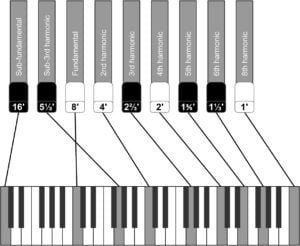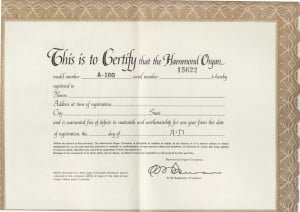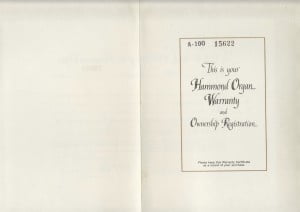Tony Monaco Trio Live – Jimmy Smith Tribute – Midnight Special
Monthly Archives: December 2015
Hammond A-100 Warranty Certificate
Hammond Organ Simple Fix for Sound, Percussion, Pops & Pings
A few simple things you can do to clean up corroded contacts and pots to get your Hammond organ running, especially if it has been sitting a while.
Cory Henry – The Revival Project
Some seriously inspiring gospel playing by Cory Henry and a great sounding B3 – cool use of the expression pedal to introduce dynamics, true gospel style with bass played on upper manual, lead below
The Hammond Drawbars secrets revealed

The drawbars on a console Hammond (B3, C3 or A100 and variants) and the clone wheels can be a source of much confusion. They are also sometimes called tone bars, and they are used to shape the sound.
Each drawbar is marked with a number in feet. As an example, the first (brown) drawbar is marked 16′. This terminology is borrowed from pipe organ technology, where this number actually describes the length of the pipe that is used to get a certain tone.
Every drawbar has eight settings, which indicate how much of a particular drawbar’s tone is added to the final signal, with 1 being the softest, and 8 being the loudest. When the drawbar is pushed in all the way, no sound from this drawbar is used in the final sound.
On a console, you will have five groups of drawbars, two for the lower manual and two for the upper manual, each of which consist of none drawbars, and one for the bass, which has two drawbars.
Drawbar colours
There are three different colours on the drawbars, brown, white and black.
The fundamental, ‘core’ tone is created by the first white drawbar. The other white drawbars are octave intervals of the fundamental tone of increasingly higher pitched notes.
The brown drawbars are the two ones to the left, and these produce harmonics below the fundamental tone. The first brown Drawbar is the sub-octave of the fundamental Drawbar. It is “one octave” lower in sound. The second brown drawbar is the “sub-octave” of the third harmonic. Pulling the brown drawbars makes the tone deeper and fuller.
The black drawbars introduce dissonant harmonics, which serve to color the tone and give it character.
Lower manual settings
The lower manual can be used either for playing walking bass, or comping chords. For the former, 808000000 works really well; add more of the 2nd drawbar to get a heavier, more ‘growly’ tone. This setting is not ideal for playing chords on the lower manual, since this makes the sound often too muddy. 008800000 seems to work better for chords down below, or you can just play them higher up the keyboard if you want to switch between walking and comping.
It is often is suggested to turn off V/C when using a walking bass – I think it can work either way, depending on the mood of the song. You can also turn off the bottom rotor to get that ‘Memphis’ sound, which also works well with walking bass lines.
Using the Leslie
Using a Leslie efficiently and effectively can be quite challenge – to get the best result, you may have to adjust you drawbar settings to get the most out of your Leslie fast setting (or, alternatively, to tame it down). If you use the Leslie on fast on your typical Jimmy Smith setting (888000000 / 808000000), you will get a very limited, subtle Leslie effect, even with the rotors on fast; if you want the highs to swirl prominently, you will have to add the higher drawbars. To stay with the Jimmy Smith idiom, try 800000888 on fast, and you’ll see what I mean. You may have to adjust your playing style to get the most out of the more extreme settings.
Some players seem to like introducing some reverb before the Leslie to get a different sound, this is something to experiment with.
Reggae Drawbar Settings for Hammond
Playing Reggae on the Hammond is a very different kettle of fish. Here’s some ideas:
Practice the ’bubble’. Many people seem to get this wrong – don’t play on the down beat, but just after it. Here’s a good video that demonstrates the technique:
The basic bubble sound is clean (no or little drive), no percussion, C3, sometimes C2; the Leslie does not always need to be on fast, the VC on its own can be very effective
Drawbar setting:
Upper:
208800004
800000008
800000003
008005000
808000008
058223678
008400004
008000000
888875568 (with 3rd perc for solos)
Sometimes the Jimmy Smith settings can also work well (888000000, or even 888800000), but depending on the organ you’re playing you may want to reduce the lower 8’s to 7s or 6s to soften the sound, and get a lighter more airy sound that may sit better in the mix.
Lower:
738000050
008400006
808000000
For that Bob Marley sound, try 864202468 upper, 808 or 838 lower
Christmas Time
https://www.wikiloops.com/backingtrack-jam-58754.php
Brian Auger
https://www.youtube.com/watch?v=njfiSoawRNo
Brian Auger is a jazz musician that uses the Hammond as his main instrument. Brian is one of the few Hammond players that does not incorporate a Leslie in his setup, and instead uses the chorus / vibrate of the Hammond to its full extent.


